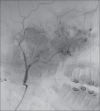Head and neck hemangiopericytoma in a child: case report
- PMID: 15558145
- PMCID: PMC11160341
- DOI: 10.1590/s1516-31802004000500010
Head and neck hemangiopericytoma in a child: case report
Abstract
Context: Hemangiopericytoma is a relatively rare tumor, first described in 1942, with approximately 300 cases described in the literature to date. In most cases, it affects the trunk and lower extremities. The head and neck incidence is less than 20%, mostly in adults. We describe a case of malignant head and neck hemangiopericytoma in a child.
Type of study: Case report.
Case report: A twelve-year-old male patient noted the presence of a firm painless right-side retroauricular lymph node of 1 cm in diameter, which at first remained unchanged for six months, but subsequently enlarged progressively. He denied having had previous trauma at that site. In November 2000, he presented nasal obstruction and voluminous epistaxis that required hospitalization and blood transfusion. During dental treatment one month later, a cranial x-ray revealed bone alterations. A subsequent computed tomography scan showed an extensive lesion of soft tissue density that had invaded the maxillary fossa, eroding the skull base and middle and nasal fossa. The child was then referred to our service, where biopsy was performed, giving a diagnosis of hemangiopericytoma. Shortly afterwards, magnetic resonance imaging revealed that this lesion had undergone significant growth, while maintaining the same invasion pattern. The patient was submitted to conservative surgery in April 2001, with only partial resection of the tumor because of its extent. Histopathological examination of the specimen confirmed the presence of malignant hemangiopericytoma. Following the surgery, the patient presented fast regrowth of the lesion, with partial response to chemotherapy and radiotherapy.
CONTEXTO:: O hemangiopericitoma é uma neoplasia relativamente, descrita pela primeira vez em 1942, e com aproximadamente 300 casos descritos até hoje na literatura. Na maioria dos pacientes, acomete o tronco e membros inferiores, sendo a incidência em cabeça e pescoço menor que 20%, e principalmente em adultos. Relatamos um caso de hemangiopericitoma de cabeça e pescoço em criança.
TIPO DE ESTUDO:: Relato de caso.
RELATO DO CASO:: Paciente do sexo masculino, 12 anos, que, em dezembro de 1999, notou nódulo retroauricular à direita, endurecido, indolor e de 1 cm de diâmetro, que evoluiu estável por seis meses e com posterior crescimento progressivo. Negava história de trauma. Em novembro de 2000, apresentou obstrução nasal e epistaxe volumosa, necessitando de internação e transfusão sangüínea. Um mês depois, durante tratamento dentário, uma radiografia craniana evidenciou alterações ósseas. Tomografia computadorizada subseqüente mostrou lesão extensa característica de partes moles, invadindo fossa maxilares, destruindo base do crânio, fossa média e fossas nasais. A criança foi encaminhada ao nosso serviço, onde biópsia foi realizada, com diagnóstico de hemangiopericitoma. Logo após exame de ressonância nuclear magnética evidenciou a mesma lesão com aumento importante, mas invadindo as mesmas estruturas. Submetido à cirurgia conservadora em abril de 2001 com ressecção parcial do tumor devido à sua extensão. O exame histopatológico revelou hemangiopericitoma maligno. Após a cirurgia, o paciente apresentou rápido crescimento da massa tumoral e resposta parcial a quimioterapia e radioterapia.
Conflict of interest statement
Figures



Similar articles
-
Haemangiopericytoma of infratemporal fossa.J Laryngol Otol. 2001 Jan;115(1):77-9. doi: 10.1258/0022215011906894. J Laryngol Otol. 2001. PMID: 11233635 Review.
-
Giant hemangiopericytoma of the neck: a case report.Kulak Burun Bogaz Ihtis Derg. 2002 Jul-Aug;9(4):297-300. Kulak Burun Bogaz Ihtis Derg. 2002. PMID: 12422087
-
[Hemangiopericytoma (extrapleural solitary fibrous tumour). Exemplified and discussed on the basis of two cases].Mund Kiefer Gesichtschir. 2005 Nov;9(6):404-8. doi: 10.1007/s10006-005-0649-x. Mund Kiefer Gesichtschir. 2005. PMID: 16220316 German.
-
Preoperative chemotherapy for congenital hemangiopericytoma and a review of the literature.J Pediatr Hematol Oncol. 1997 May-Jun;19(3):247-50. doi: 10.1097/00043426-199705000-00013. J Pediatr Hematol Oncol. 1997. PMID: 9201149 Review.
-
Extra- and intracranial dumbbell-shaped hemangiopericytoma.Eur Arch Otorhinolaryngol. 2008 Apr;265(4):481-4. doi: 10.1007/s00405-007-0466-y. Epub 2007 Oct 2. Eur Arch Otorhinolaryngol. 2008. PMID: 17909827
Cited by
-
Primary haemangiopericytoma of the parapharyngeal space: an unusual tumour and review of the literature.Acta Otorhinolaryngol Ital. 2011 Jun;31(3):194-8. Epub 2011 Mar 16. Acta Otorhinolaryngol Ital. 2011. PMID: 22058597 Free PMC article. Review.
-
Rare association of cystic squamous cell carcinoma and small lymphocytic B cell lymphoma: successful surgical approach.Wien Med Wochenschr. 2017 Apr;167(5-6):104-109. doi: 10.1007/s10354-016-0510-x. Epub 2016 Sep 8. Wien Med Wochenschr. 2017. PMID: 27631871
-
Sacro-anterior haemangiopericytoma: a case report.Cancer Biol Med. 2014 Jun;11(2):139-43. doi: 10.7497/j.issn.2095-3941.2014.02.010. Cancer Biol Med. 2014. PMID: 25009757 Free PMC article.
-
Hemangiopericytoma of the tongue.Braz J Otorhinolaryngol. 2012 Apr;78(2):136. doi: 10.1590/S1808-86942012000200024. Braz J Otorhinolaryngol. 2012. PMID: 22499385 Free PMC article. No abstract available.
-
Parapharyngeal space hemangiopericytoma treated with surgery and postoperative radiation--a case report.Head Neck Oncol. 2012 Apr 5;4:10. doi: 10.1186/1758-3284-4-10. Head Neck Oncol. 2012. PMID: 22480217 Free PMC article.
References
-
- Weiss EA. Soft Tissue Tumors. 3 ed. St. Louis, Missouri: Mosby Publication; 1995. pp. 713–729.
-
- Zimmermann KW. Der feinere Bau der Blutcapillaren. Z Anat Entwicklungsgesch. 1923;68:29–109.
-
- Catalano PJ, Brandwein M, Shah DK, Urken ML, Lawson W, Biller HF. Sinonasal hemangiopericytomas: a clinicopatho-logic and immunohistochemical study of seven cases. Head Neck. 1996;18(1):42–53. - PubMed
-
- Hervé S, Abd Alsamad I, Beautru R, et al. Management of sinonasal hemangiopericytomas. Rhinology. 1999;37(4):153–158. - PubMed
Publication types
MeSH terms
LinkOut - more resources
Full Text Sources
Medical
Research Materials
Miscellaneous

